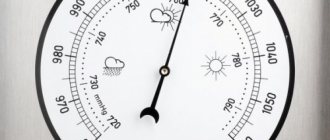Meteorology books often describe the Earth's atmosphere as a vast ocean of air in which we all live. Various diagrams depict our planet surrounded by a huge atmospheric sea several hundred kilometers high, divided into several different layers. But the layer of our atmosphere that supports all life is actually extremely thin—just over 5 km thick. The part of our atmosphere that can be measured with some degree of accuracy rises to about 40 kilometers. Moreover, it is almost impossible to give a precise answer about where the atmosphere ultimately ends; Somewhere between 400 and 500 km there is an undefined region where the air gradually thins and eventually dissolves into the vacuum of space.
So the layer of air surrounding our planet is not that big after all. As one famous meteorologist so eloquently put it: “The Earth is not suspended in a sea of air—it is suspended in a sea of space, and there is an extremely thin layer of gas on its surface.”
And this gas is our atmosphere.
If a person climbs a high mountain, such as Mauna Kea on the island of Hawaii, whose peak reaches 4206 meters above sea level, there is a high risk of suffering from altitude sickness (hypoxia). Before reaching the summit, visitors stop at an intermediate camp located at an altitude of 2804 m, where they must acclimatize to the altitude before continuing further up the mountain. “Well, of course,” you might say, “everyone knows that the amount of oxygen available at such high altitudes is significantly less compared to what is available at sea level.”
But in making such a statement, you are mistaken!
In fact, 21% of the Earth's atmosphere consists of life-giving oxygen (78% is nitrogen, and the remaining 1% is other gases). And this ratio in proportions is almost the same both at sea level and high in the mountains.
The big difference is not the amount of oxygen present, but rather its density and pressure.
Air is often compared to the ocean using the term "ocean of air", and this is true because we are all literally floating in the air. Now imagine this: a tall plastic bucket is filled to the brim with water. Now make a hole in the top of the bucket. The water will drain slowly. Now make another hole at the bottom near the bottom. What will happen? Water will rapidly flow out from the bottom hole in a strong stream. The reason is the difference in pressure. The pressure exerted by the weight of the water below at the bottom of the bucket is greater than at the top, so the water is “squeezed out” more strongly from the hole below.
Likewise, the pressure of all the air above us is the force that pushes air into our lungs, thereby delivering oxygen into the bloodstream. Once this pressure is reduced (for example, when we climb a high mountain), less air enters the lungs, therefore less oxygen reaches our bloodstream, resulting in hypoxia; again, not due to a decrease in the amount of available oxygen, but due to a decrease in atmospheric pressure.
What is atmospheric pressure?
Atmospheric pressure is the pressure of the gaseous shell of our planet, the atmosphere, which acts on all objects in it, as well as the earth's surface. Pressure corresponds to the force that acts in the atmosphere per unit area.
Earth's atmosphere (photo from the ISS)
In simpler terms, this is the force with which the air around us acts on the surface of the earth and objects. By monitoring changes in atmospheric pressure, it is possible, in conjunction with other factors, to predict weather conditions.
Test to consolidate learned material
Test on the topic: “Atmospheric pressure”
Sources:
- Tomilin A. N., Terebinskaya N. V. Why nothing? Essays. /L., “Det. lit.”, 1975.
- Ya. I. Perelman. Entertaining tasks and experiments. - M.: “Children's Literature”, 1972.
- Physical Geography: Reference. aid for preparation. dept. universities/G. V. Volodina, I. V. Dushina, S. G. Lyubushkina and others; Ed. K.V. Pashkanga - M.: Higher. school, 1991.
- Tarasov L.V. Atmosphere of our planet. - M.: FIZMATLIT, 2012.
- Savtsov T.M. General geography: Textbook. aid for students higher ped. textbook institutions - M.: Publishing House, 2003
- Dronov V.P. Geography. 5-6 grades: Textbook/V. P. Dronov, L. E. Savelyeva. 5th ed., stereotype. - M.: Bustard, 2015.
- Geography grades 5-6: textbook. for general education institutions / A. I. Alekseev, E. K. Lipkina, V. V. Nikolina, etc.; Edited by A. I. Alekseev. - M.: Education, 2012.
Why and due to what is atmospheric pressure created?
Specialists who study the Earth's atmosphere and various meteorological phenomena carefully monitor how air masses move. This is the main factor influencing the climatic conditions of a particular area. These observations made it possible to understand why atmospheric pressure arises.
It's all because of gravity.
Through many experiments it has been proven that air is by no means weightless. It consists of various gases that have a certain weight. Thus, the force of gravity of the Earth acts on the air, which contributes to the formation of pressure. Interesting fact : all the air on the planet (or the entire atmosphere of the Earth) weighs 51 x 1014 tons.
The air mass around the globe is not the same. The level of atmospheric pressure fluctuates accordingly. Areas with more air mass experience higher pressure. If there is less air (it is also called rarefied in such cases), then the pressure is lower.
Movement Sun
Why does the weight of the atmosphere change? The secret of this phenomenon lies in the heating of air masses. The fact is that the heating of the air does not occur at all from the sun's rays, but due to the earth's surface.
Near it, the air heats up and, becoming lighter, rises. At this time, the cooled flows become heavier and fall down. This process occurs continuously. Each air flow has its own pressure, and its difference causes wind.
Introduction
It's raining outside the window today.
After the rain, the air temperature decreased, humidity increased and atmospheric pressure decreased. Atmospheric pressure is one of the main factors determining the state of weather and climate, so knowledge of atmospheric pressure is necessary in weather forecasting. The ability to measure atmospheric pressure is of great practical importance. And it can be measured with special barometer devices. In liquid barometers, as the weather changes, the liquid column decreases or increases. Knowledge about atmospheric pressure is necessary in medicine, in technological processes, in human life and in all living organisms. There is a direct connection between changes in atmospheric pressure and changes in weather. An increase or decrease in atmospheric pressure can be a sign of weather changes and affect a person’s well-being.
Description of three interrelated physical phenomena from everyday life:
- Relationship between weather and atmospheric pressure.
- Phenomena underlying the operation of instruments for measuring atmospheric pressure.
- Dependence of liquid pressure on the height of the liquid column in liquid barometers.
Relevance of the work
The relevance of the chosen topic is that at all times people, thanks to their observations of animal behavior, could predict weather changes, natural disasters, and avoid human casualties.
The influence of atmospheric pressure on our body is inevitable; sudden changes in atmospheric pressure affect a person’s well-being, and weather-dependent people especially suffer. Of course, we cannot reduce the influence of atmospheric pressure on human health, but we can help our own body. The ability to measure atmospheric pressure, knowledge of folk signs, and the use of homemade instruments can help to properly organize your day, distribute time between work and rest.
Purpose of the work: to find out what role atmospheric pressure plays in human daily life.
Tasks:
- Study the history of atmospheric pressure measurement.
- Determine whether there is a connection between weather and atmospheric pressure.
- Study the types of instruments designed to measure atmospheric pressure, made by man.
- Study the physical phenomena underlying the operation of instruments for measuring atmospheric pressure.
- Dependence of liquid pressure on the height of the liquid column in liquid barometers.
Research methods
- Literature analysis.
- Summarizing the information received.
- Observations.
Field of study: atmospheric pressure
Hypothesis : atmospheric pressure is important for humans.
Significance of the work : the material of this work can be used in lessons and in extracurricular activities, in the lives of my classmates, students of our school, and all lovers of nature research.
Work plan
I. Theoretical part (information collection):
- Review and analysis of literature.
- Internet resources.
II. Practical part:
- observations;
- collecting weather information.
III. Final part:
- Conclusions.
- Presentation of work.
How does the composition of the atmosphere affect pressure?
The atmosphere contains a huge amount of gases. These are mainly nitrogen and oxygen (98%). There is also carbon dioxide, neon, argon, etc. The atmosphere begins with a boundary layer 1-2 km thick and ends with the exosphere at an altitude of about 10,000 km, where it smoothly passes into interplanetary space.
Atmospheric composition
The composition of the atmosphere affects pressure due to density. Each component has its own density. The higher the altitude, the thinner the layer of the atmosphere and the lower its density. The pressure decreases accordingly.
How to protect yourself
It is not possible to completely eliminate the influence of the atmosphere on everyday life. The weather is unpredictable every day, so you need to know everything about your health and take measures to alleviate the condition. Measures necessary for hypotensive patients:
- sleep well;
- take a contrast shower (changing the water temperature from warm to cool and vice versa);
- drink strong tea or natural coffee;
- harden the body;
- drink more clean water;
- take long walks in the fresh air;
- take natural medications that strengthen the immune system.
Atmospheric pressure has a greater effect on hypertensive patients. They can usually immediately sense an impending change in weather conditions. To reduce dependence on such changes, hypertensive patients need:
- do not be in the open sun;
- avoid overheating;
- exclude foods containing large amounts of caffeine from the diet; fatty foods;
- reduce daily physical activity;
- rest more;
- be sure to monitor blood pressure;
- take antihypertensive drugs.
Atmospheric pressure measurement
In the International System of Units, atmospheric pressure is measured in pascals (Pa). Also in Russia, units such as bar, millimeters of mercury and their derivatives are used. Their use is due to instruments that measure pressure - mercury barometers. 1 mmHg corresponds to about 133 Pa.
There are two types of barometers:
- liquid;
- mechanical (aneroid barometer).
Liquid barometers are filled with mercury. The invention of this device is the merit of the Italian scientist Evangelista Torricelli. In 1644, he conducted an experiment with a container, mercury and a flask, which was lowered into the liquid with an open hole.
Interesting: Rain: why it comes, reasons, how it is measured, photos and videos
As the pressure changed, the mercury rose and fell in the flask. Modern mercury barometers with scales are considered the most accurate, but not very convenient, so they are used at meteorological stations.
Barometers
Aneroid barometers are more common . The design of such a device includes a metal box with rarefied air inside. When the pressure decreases, the box expands. With increasing pressure, the box compresses and acts on the attached spring. The spring moves a pointer that displays the pressure level on a scale.
Interesting fact : there is a standard unit of pressure (as well as other units of physical quantities). The primary standard, which displays absolute pressure as accurately as possible, is located at the All-Russian Mendeleev Research Institute of Metrology (St. Petersburg).
Normal atmospheric pressure for humans
Normal atmospheric pressure is 760 mmHg or 101,325 Pa at 0℃ at sea level (45º latitude). At the same time, the atmosphere acts on every square centimeter of the earth's surface with a force of 1.033 kg. A column of mercury 760 mm high balances the mass of this air column.
The figure of 760 mm was also determined by Torricelli during the experiment. He also noticed that when a flask is filled with mercury, there is a void at the top. Subsequently, this phenomenon was called the “Torricelli void.” Then the scientist did not yet know that during his experiment he created a vacuum - that is, a space free from any substances.
At a standard pressure of 760 mmHg a person feels most comfortable. If we take into account the previous data, then the air presses on a person with a force of about 16 tons. Why then do we not feel this pressure?
The fact is that there is also pressure inside the body. Not only people, but also representatives of the animal world have adapted to atmospheric pressure. Each organ was formed and developed under the influence of this force. When the atmosphere acts on a body, this force is distributed evenly over the entire surface. Thus, the pressure is balanced and we do not feel it.
Atmospheric pressure map of Russia
The atmospheric pressure norm should not be confused with the climate norm. Each region has its own standards for a certain time of year. For example, residents of Vladivostok are lucky, since the average annual atmospheric pressure there is almost equal to the norm - 761 mm Hg.
And in settlements located in mountainous areas (for example, in Tibet), the pressure is much lower - 413 mm Hg. This is due to the altitude of about 5000 m.
Why is weather sensitivity dangerous?
Weather sensitivity is not such a harmless disorder as one might assume. Under the influence of the vagaries of the weather, different systems of the body suffer.
Immunity. Frequent changes in climatic conditions lead to the fact that the immune system is depleted, as it works in enhanced mode for a long time. As a result, a person gets sick easier and more often.
The cardiovascular system. Sudden changes in weather conditions cause the release of stress hormones, which provoke blood thickening, which creates additional risks for people with cardiovascular diseases, metabolic syndrome, diabetes, and vegetative-vascular dystonia. Therefore, people at risk should take blood thinners on the day the weather changes and a day earlier (but only as prescribed by a doctor).
Endocrine system. A sudden change in weather is stressful for the entire body, including the endocrine system. In particular, as for the pancreas, an unstable weather situation is one of the reasons for its depletion, and, therefore, a disruption in insulin production. The result is increased blood sugar and a tendency to develop diabetes. That is why, in adverse weather conditions, it is advisable for even healthy people to control their blood sugar levels. And people with diabetes must do this.
Increase and decrease in pressure
When the pressure exceeds 760 mm. Hg Art., it is called elevated, and when the indicator is less than normal - reduced.
Several changes in atmospheric pressure occur within 24 hours. In the morning and evening it increases, and after 12 noon and night it decreases. This happens due to the fact that the air temperature changes and, accordingly, its flows move.
During the winter period, the highest atmospheric pressure is observed over the mainland of the Earth, because the air has a low temperature and is highly dense. In summer, the opposite situation is observed - minimal pressure is observed.
On a more global scale, pressure levels also depend on temperature. The Earth's surface heats up unevenly: the planet has a geoid (rather than perfectly round) shape and revolves around the Sun. Some zones heat up more, others less. Because of this, atmospheric pressure is distributed zonally over the surface of the planet.
Atmospheric pressure belts
Scientists identify 3 belts where low pressure predominates and 4 belts with predominant highs. The equator area warms up the most, so light warm air rises, and low pressure forms at the surface.
Interesting: Insects in amber - how they get there, description, photos and videos
Near the poles, the opposite is true: cold air sinks, so there is high pressure. If you look at the diagram of pressure distribution over the surface of the planet, you will notice that the belts of minimums and maximums alternate.
In addition, you need to remember about the uneven heating of both hemispheres of the Earth throughout the year. This leads to a certain displacement of the low and high pressure belts. In summer they move northwards, and in winter – southwards.
From the history of the discovery of knowledge about weight, air pressure and the invention of the barometer
E. Torricelli , figured out how to measure atmospheric pressure . Together with V. Viviani , a young student of Galileo, he conducted experiments to measure it. Torricelli was also one of Galileo's last students, and based on his guesses, he proved that air has weight and exerts pressure.
Evangelista Torricelli and his barometer. Author: Saperaud~commonswiki
Torricelli was the first to openly oppose Aristotle's dogmas. Speaking about the pump, he stated that
“First of all, the water rises after the piston not at all because “nature is afraid of emptiness,” it’s just that the water is driven into the pump by the pressure that the air exerts on the surface of the river. There is no air in the pump pipe, under the piston, so water enters it until the weight of the water column in the pump pipe balances the external air pressure.”
But he proved it a little later. The experiment he proposed was carried out in 1643. In this experiment, a glass tube about 1 m long was used, sealed at one end. It was filled with mercury and, having closed it with a finger (so that the mercury did not spill out ahead of time), turned it over, and lowered it into a wide cup with mercury.
Some of the mercury poured out of the tube, and a vacuum formed in its upper part (the first real void discovered on Earth - the Torricelli void ). In this case, the height of the mercury column in the tube turned out to be approximately 760 mm (if measured from the level of mercury in the cup). The air pressed on the mercury of the cup and did not allow it to flow out of the tube.
The scientist also guessed that atmospheric pressure is associated with weather changes. Observing the height of the mercury column in the tube, Torricelli noticed that atmospheric pressure was not constant and depended on “warmth or cold.” The column in the tube lowered and then rose, indicating the desired division of the scale. That is why millimeter of mercury (mmHg) is taken as one of the units of pressure. Gravity in Greek is "baros", and Torricelli's device began to be called a barometer .
Operating principle of the Torricelli barometer
Almost simultaneously with Torricelli, another famous scientist of that time, Descartes, . He explained why perfume does not flow out of a bottle with a hole in the bottom when the lid is closed, but does flow out when it is open, precisely because of the difference in air pressure on different surface areas. When the bottle cap is closed, the surface tension of the water at the small opening is able to hold the liquid in the bottle. When the lid is open, it is overcome by the force of air pressure and the perfume begins to flow out. Descartes hypothesized that with height the air becomes thinner, which means its pressure should also decrease.
After Torricelli’s experiments, Descartes instructed the talented French mathematician and physicist Blaise Pascal to test his guess - whether it was true that pressure decreases with height. To do this, he had to climb the mountains with Torricelli's pipe. The descending column of mercury at the height of Mount Puy de Dome confirmed the hypotheses of Torricelli and Descartes.
Pascal concluded:
“the laws of fluid pressure, known since the time of the glorious Archimedes and developed by the Dutchman Simeon Stevin , are in many ways valid for air.”
Air pressure is not noticed by a person, because according to the laws of pressure in liquids and gases, it is directed both to the sides and down.
Impact on humans
Atmospheric pressure has a serious impact on the human body. This is quite natural, if we take into account all of the above regarding the force with which the air presses on our body and the resistance provided.
How changes in weather affect people
There is a concept of meteorological dependence, confirmed by science and medicine. Meteopaths are people whose body reacts to even minimal pressure deviations from the norm. These also include people with certain chronic diseases (in particular cardiovascular, nervous system, etc.).
In general, the human body can adapt to changing climatic conditions. For example, when traveling to a country with completely different weather conditions, it may take several days to acclimatize.
Significant deviations from the norm will be noticeable for absolutely any person. This includes both high and low blood pressure.
In ordinary life, an increase in atmospheric pressure to a critical level, at which a person’s well-being deteriorates, does not occur (with the exception of the above-mentioned weather-dependent and chronically ill people). You can feel its effect, for example, when diving to great depths.
Low and high blood pressure
Low atmospheric pressure is more dangerous. Its effects can be easily felt at high altitudes. There is a concept of altitude sickness, in which the amount of carbon dioxide increases. In this case, the volume of oxygen, on the contrary, decreases, so the body tissues feel oxygen starvation. The vessels quickly react to this, provoking a sharp increase in pressure in the body.
Why do we react to the weather?
The human body is designed in such a way that it is able to resonate to any changes in weather conditions. Any weather changes do not go unnoticed by our body. The reason for this relationship is usually called our nerve receptors, which, like antennas, detect weather changes. As a result, the entire body adapts to certain signals from nerve cells, and in this case, organs and systems temporarily switch to functioning in a state of stress, that is, “increased combat readiness.” The outcome of such events is easy to predict: the most weakened systems begin to malfunction. In some people the cardiac system reacts, in others the nervous system reacts, and still others complain of digestive problems.
But here’s the question: why do some react extremely painfully to changes in weather, while others don’t even notice weather vagaries. The whole reason is the body’s ability to adapt and adapt to natural phenomena. If the adaptation mechanisms in the body work properly, then the person does not react in any way to changes in the weather outside the window. Otherwise, we have to talk about weather dependence or weather sensitivity.
Cyclone
A cyclone is a huge mass of air that rotates in the form of a vortex around a vertical axis with a diameter of up to several thousand kilometers. At the center of this vortex there is low pressure.
Cyclones
In the Northern Hemisphere, the atmospheric vortex of a cyclone rotates counterclockwise, in the Southern Hemisphere it rotates clockwise. Cyclones occur regularly, since their formation is directly related to the rotation of the Earth. There are no cyclones near the equator.
There are two types of cyclones:
- Tropical. They occur in tropical latitudes and are relatively small in size. However, they are characterized by enormous, destructive wind power.
- Extratropical. Formed in polar and temperate latitudes. They reach several thousand kilometers in diameter.
Interesting fact : in tropical cyclones, the “eye of the storm” is often observed - this is an area of about 20 km in size in the very center of the vortex, in which clear and calm weather remains.
The main distinguishing features of a cyclone are colossal energy, which manifests itself in the form of strong winds, storms, thunderstorms, squalls, and precipitation. Powerful tropical cyclones are given unique names or names, for example, Katrina (2005), Nina (1975), Dorian (2019).
Cold fronts
Los cold fronts are those in which a mass of cold air replaces hot air . They are strong and can cause atmospheric disturbances such as thunderstorms, rainstorms, tornadoes, high winds and short snowstorms before the passage of a cold front, followed by dry conditions as the front advances. Depending on the time of year and its geographic location, cold fronts can last from 5 to 7 days in a row.
Cold wind
Anticyclone
An anticyclone is not only the opposite of a cyclone. This phenomenon has a different mechanism of occurrence. The wind in both hemispheres of the Earth moves in the opposite direction compared to the cyclone.
Anticyclone
An anticyclone is an area of high pressure. It is characterized by closed isobars - these are lines that mark places with the same atmospheric pressure.
An anticyclone brings stable weather conditions corresponding to the time of year. In summer it is windless, hot weather, in winter it is frosty. Characterized by few or no clouds.
Interesting:











